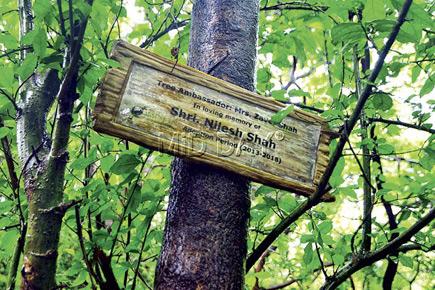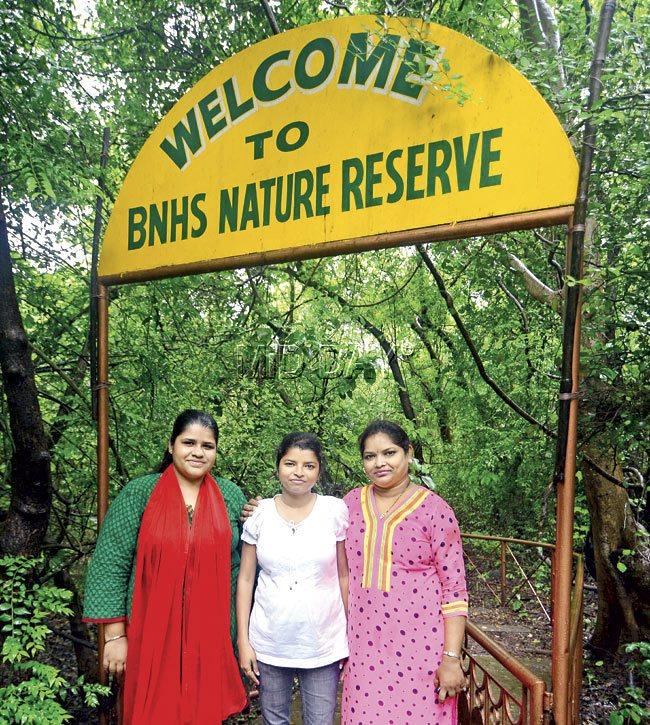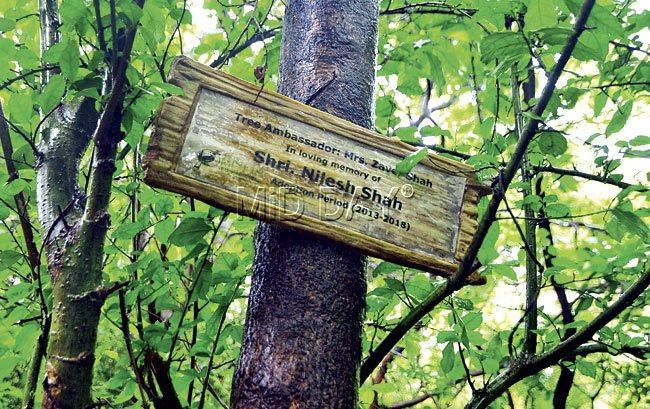In a city of over 20 million people, only 17 patrons respond to an appeal for adoption of trees in the Bombay Natural History Society's Nature Reserve in Goregaon

 Over 125 tall trees make a resplendent presence in a 33-acre plot in Goregaon. These trees have been around for a while, approximately for 50 years. They existed much before they became a part of the Nature Reserve owned by the Bombay Natural History Society (BNHS).
Over 125 tall trees make a resplendent presence in a 33-acre plot in Goregaon. These trees have been around for a while, approximately for 50 years. They existed much before they became a part of the Nature Reserve owned by the Bombay Natural History Society (BNHS).
ADVERTISEMENT
Last year, when the BNHS was thinking of ways to commemorate the 20 years conservation education work in the Goregaon Reserve, a fraction of the group thought of projecting the trees as possible tools for fund-raising. What followed was an appeal to the people of Mumbai to adopt these trees and help the cause of biodiversity research.

Priti Choghale (c) with Amandeepkaur Giran (l) Deepa Fernandes (r) at the Bombay Natural History Society (BNHS) Nature Reserve in Goregaon. Pics/Kaushik Thanekar
Bio-datas of the trees were put on display and people were called upon to make their choices. The appeal was jazzed up with add-on features like an offer of a ceremony where the patron would be photographed with the adopted tree. The tree’s coordinates (in terms of the global positioning system) and the pictures of the flowers and fruits it bears would be either emailed or physically posted to the adopter.

Commitment is key to adopting a tree
Plans were announced to call patrons’ families for adoption anniversaries thereafter. Much on the lines of Adopt A tree initiatives (Example: Hawaii) of the Western world, the BNHS termed the adoption as “a fun and easy way to help the environment... a unique, affordable and long-lasting gift or memorial.”

The concept needs to be broadbased and infused with vigour to appeal to more people
The BNHS drive, publicized through the society website and newspaper media alerts in August 2013, received attention from 17 ambassadors. Most of these patrons were in some way associated with the Society’s initiatives. A few were visitors or conductors of the Sunday Nature trails. For instance, Dr Ketki Marthak, who adopted a Red Silk Cotton tree, is part of the faculty. She has dedicated the adopted tree to her departed father.
Similarly, Geeta Samant, whose husband is associated with the making of the Nature Reserve, took care of a Yellow Silk Cotton tree. Senior citizen Bhalchandra Barve and his wife, were among the few who made a personal effort to reach out to BNHS after learning about the adoption offer. They adopted four trees and want to repeat this gesture every year.
One patron, based in Taiwan, adopted a tree only to bring home the importance of a natural habitat for his company employees. A collegian expended his pocket money to satisfy his urge “to belong to a tree.” Shishir Goenka, the founder of an organic clothing brand (Do you speak green?) adopted because “giving support to all forms of natural life gives me joy.”
Delhi-based Kanika Pal showed interest in adoption but ultimately backed out because of the price tag of Rs 10,000 per tree. There were a few patrons who inquired about the possibility of “getting the produce” in the form of fruits and tree wood! They were disappointed because of the protected flora and fauna in the Nature Reserve.
It is a feeling!
It is not just the paucity of ambassadors that is palpable in this tree adoption initiative, but several other moot points are worth mulling over. Adoption is a one-off activity for almost all patrons. Given the time pressures of Mumbai, very few patrons have time to visit the Nature Reserve and take joy from the trees they have adopted.
Therefore the larger purpose of encouraging people to spend time with trees is underserved. “Being not-so-mobile senior citizens, a visit to Goregaon is out of the ambit of possibilities for us. We are just happy to know that we adopted a tree.
Our son-in-law who stays close to the reserve picked up the adoption certificate for us,” state the Barves who live in Bandra and prefer not to venture out because of the traffic jams. Like the Barves, most of the patrons are happy with the idea of donating a green tree to the memory of the departed souls.
The lack of involvement of people in the post-adoption process stems from another fact. All the adopted trees are full-blown and strong, leaving very little scope for a care-giver with the best intentions.
The BNHS Reserve shares its borders with the rich jungle of the Sanjay Gandhi National Park (SGNP) and the Film City at Goregaon. Naturally, trees which have assumed full form do not allow their patrons to witness a growth graph (sapling to a healthy tree), which is a pleasure in itself.
Gift Idea
For any such fund-raising activity to succeed, civil society and groups like the BNHS should first make efforts to create a climate where trees are accepted as gifts in the popular space.
Unless tree adoption is seen as a sellable ‘cool’ gift idea, any tree adoption initiative will not achieve optimal results, which is why membership-driven groups (like the 130-year-old BNHS) have to use innovative media to transcend their immediate friend circle.
The Society needs to build new bridges with other Non-Governmental Organizations (NGOs) and the corporate world. It has to embrace a larger humanity than the customary crowd that comes for its projects and well-intentioned activities like Flamingo watch at Sewree or the ‘Overnight Barbeque Cooking Class with our Chef in the Wild!’ or the ‘Nature Detectives Challenge 2013.’
Unless younger and wider audiences are reached, the activities will only preach to the converted. Mumbai is a home to world class designers and ideation teams. The BNHS needs to network with a fresh team of young Mumbaikars who will lend their expertise to a green cause.
An interactive and more colourful design for the BNHS website can be a good starting point. Such networking requires time and a collective readiness for infusing new people in the organizational set up.
Adoption is cohesive
In the popular consciousness, adoption is synonymous with care-giving for a single tree. Organizations like the BNHS have to work towards erasing this simplistic notion. People need to be told that adoption is not about watering a tree, which is anyways limited to the initial years. Adoption is a larger cause. It is about awakening a city to its rich tree heritage.
It is about ensuring that mindless massacre of trees does not happen in the name of trimming. It is about taking care of trees when municipal authorities dig up the manholes. It is about identifying the common diseases suffered by a certain species. Adoption is about all this and much more.
And who can be a more legitimate advocate of Mumbai’s trees than a respectable organization like the BNHS? If the BNHS becomes a voice for issues that affect Mumbai's trees, people will be made more aware of the tree policy of the government.
If the BNHS closely follows the working of the Tree Authority and the Garden Department which influences the condition of the 19 lakh-odd trees in Mumbai, the city’s green cover will have a competent ambassador. In this way, the BNHS will be able to live up to its own stated mission goal: “Conservation of Nature, primarily Biological Diversity, through Action based on Research, Education and Public Awareness.”
Plant a thought
The BNHS can channelize tree lovers’ energies by encouraging people to donate money to advocacy groups which are working for trees. Dissuaded against counter-productive tree plantation drives, people can be educated about long-term associations with natural habitats.
A number of private and political groups declare arbitrary tree plantation, which often leads to plantation of unsuitable tree species for Mumbai’s ecosystem. People prefer plantation drives because they feel nice about their ‘green’ credentials.
But the BNHS and similar groups can intervene and question the ‘feel good’ factor. They need to sensitize the common tree lover and train him or her to put enough detailing and thought in the tree plantation or adoption projects.
Success abroad
Tree adoption, if done with clarity, can be a valid fund-raising drive. The success story of the Hudson River Park Support the Trees Campaign (Manhattan, New York) is inspiring in this context. Since the waterfront park takes care of its own maintenance, it appeals to donors to sponsor trees in the precinct.
The campaign asks specific questions about the ‘level of adoption/commitment,’ asking if the patron is interested in adopting a sapling or a shaded canopy or a root network or an entire grove. Adoption appeals are usually tailored to major American Holidays and festivals where people are more likely to give a gift in the form of a tree.
Patrons have been encouraged to use the new online program, launched by the Friends of Hudson River Park, to support and protect the green space and help restore its beauty after a hurricane attack. The mission of the Save the Redwoods League (California) is also another restoration of a forest, by way of adoption, which has brought people closer to the rivers and wildlife that surround the trees.
Californians, who have dedicated a grove or a redwood tree, have played a role California’s forest history. The idea of the Redwoods League is to “connect people with the peace and beauty of the tree, so that these wonders of the natural world flourish.”
Mumbaikars can also rise to the occasion if guided by well-meaning organizations like the BNHS whose years of goodwill can be put to judicious ‘green’ use. To quote the founder of the World Wide Fund for Nature, Peter Scott, “The conservationist’s most important task, if we are to save the Earth, is to educate.”
Sumedha Raikar-Mhatre is a Mumbai-based cultural chronicler
 Subscribe today by clicking the link and stay updated with the latest news!" Click here!
Subscribe today by clicking the link and stay updated with the latest news!" Click here!






